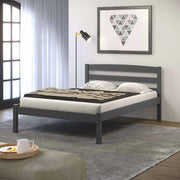
When it comes to maximizing space in small living areas, loft beds offer a practical solution. These versatile pieces of furniture elevate the sleeping area, freeing up valuable floor space for other activities or storage. Loft beds are an ideal choice for apartments, dorm rooms, and homes where efficient use of space is crucial.
Different types of loft beds cater to various needs and preferences. For children, playful designs often incorporate slides or playhouses, while adults may prefer a loft bed with a desk or storage underneath, providing both functionality and convenience.
With many options available, loft beds can seamlessly integrate into any room's decor. They come in a range of materials and styles, from sleek metal frames to rustic wooden designs. This flexibility makes them a popular choice for anyone looking to optimize their living space without sacrificing style.
Design Features and Practical Considerations
When choosing a loft bed, various factors come into play, such as the materials used, safety features, space optimization, and style preferences. Each aspect can significantly affect the bed's performance and the overall user experience.
Material Quality and Durability
Loft beds are commonly constructed from wood, metal, or a combination of both. Solid wood construction offers a timeless aesthetic and is particularly sturdy, making it suitable for both kids and adults. Types of wood used include pine, which is more affordable, and hardwoods, which are generally more durable.
Metal loft beds often have a slimmer profile and can be lighter, but high-quality metals ensure they remain sturdy and durable. It's essential to check the weight limit to ensure it can safely support the intended user.
Safety Features
Safety is paramount, especially for kids and teens. Most loft beds come with guardrails to prevent accidental falls. Guardrails should be high enough and securely attached. A well-designed ladder or stairway is crucial for safe access to the bed. Some models also feature safety rails on ladders for added protection.
Look for certifications or safety standards from recognized bodies to ensure the bed meets safety regulations. This is particularly important for beds intended for children and teenagers.
Optimizing Space with Loft Beds
Loft beds are ideal for maximizing vertical space, especially in small bedrooms. By elevating the bed, the space underneath can be utilized in various ways. Storage solutions such as built-in shelves, drawers, or a dresser can help keep the area organized.
For older kids, teens, or adults, a workspace under the bed, including a desk with shelves, can be highly beneficial. This setup is particularly popular among students and professionals who need a compact yet functional study area.
Aesthetics and Style Choices

Loft beds come in various styles and finishes to match different décor preferences. Color options often include white, black, gray, and silver. Wood options may include natural pine or other stained finishes.
For a cohesive look, some models coordinate with other furniture pieces such as dressers or nightstands. Whether the style leans towards modern, rustic, or classic, there’s likely a loft bed to suit every taste. Brands like Ikea offer a wide range of stylish yet functional loft beds.
By carefully considering these aspects, buyers can find a loft bed that not only meets their practical needs but also enhances the room's aesthetics.
Selecting the Right Loft Bed
Choosing a loft bed involves considering various factors such as size, additional functionalities, and accessibility features. It's important to select one that fits the user’s needs, space constraints, and budget.
Size and Type Variations
Loft beds come in multiple sizes, typically twin and full. Choosing the right one depends on the room’s dimensions and the user’s requirements.
A twin mattress loft bed is ideal for smaller spaces or for younger children. Full-size beds are better for older kids or teens who need more sleeping space.
Consider weight capacity as it varies between models. Make sure the bed can handle the intended user's weight plus additional loads from accessories like desks or bookshelves. Elevated beds can sometimes double as bunk beds, providing flexibility in configuration.
Additional Functionalities
Many loft beds incorporate built-in storage solutions like cubbies, drawers, and wardrobes. These features maximize space and provide extra storage for toys or clothing.
Some models include a desk space under the bed, creating a designated zone for reading or studying. Adding a desk chair complements this feature, making it a versatile furniture piece.
Accessories like slide-outs or play areas enhance functionality, especially for a child's room. Look for models that offer white glove delivery to simplify setup and ensure proper assembly without worrying about safety due to complicated instructions or poorly drilled holes.
Accessibility and User Experience
Ladders are a crucial aspect of loft beds, and their design affects accessibility and safety. Some beds feature inclined ladders, which are easier to climb but might take up more space.
Consider the bed's height and if it's appropriate for the room's ceiling height. For safety, ensure the loft bed has proper guardrails installed. The design should also accommodate the user’s routine, whether it's sleep or reading before bed.
Make sure the chosen model meets the age limits and safety standards, especially if it’s for a child, to avoid any risk during use.










